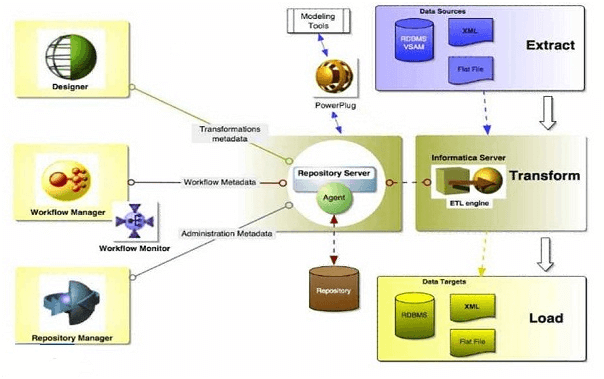
We have many use cases for Informatica, in this blog, we will discuss the best of them. Informatica is a software development tool that provides data integration products, such as ETL, data masking, master data management, data replica, data quality, data virtualization. In the Informatica power center, an ETL/Data integration tool is the most popular tool used in Informatica. It is used for the ability to connect data and fetch data, from different sources to process the data.
Interested in learning use cases of Informatica, Talk with our experts at Informatica online training Types of Use cases for Informatica
Server Components
1.Repository server. 2.Informatica server.
Repository server
Especially the Repository server used to maintain the connections, with the power center, clients and separate them in a multi-threaded process. Insert the metadata inside the repository. And it is Responsible to fetch data and maintain the consistency inside the repository metadata.
Informatica server
Informatica server is an executing engine, for the tasks created in Informatica, and a user executes data in a workflow of Informatica and suggests integration service to execute the workflow. Similarly, It reads Informatica server workflow and its repository, once the execution is completed. In particular, the task status updated after completing the execution of the workflow log and session log generation.
Client Component:
In the client, a component divided into four ways they are:
1.Designer. 2.Monitor. 3.Manger. 4.Repository Manager.
Generally, Clients access the repository by using, repository service and manage a repository that exists in the Informatica server known as a repository server. Conversely, Single repository service handles only one repository. However, It will execute multiple nodes, to increase the performance. For example, it uses locks on the object, by that multiple users will not modify the same object at the same time.
||{"title":"Master in Informatica ","subTitle":"InformaticaTraining by ITGURU's","btnTitle":"View Details","url":"https://onlineitguru.com/informatica-online-training-placement.html","boxType":"reg"}||
In the repository, Objects made by three states.
Impacted
Generally, Impacted objects are child objects that invalid in mapping. Moreover, When using a reusable transformation object. It marked as impacted.
Valid
Valid objects used to correct the syntax, Especially on Informatica and execution of workflows.
Invalid
Invalid objects do not follow the standard or specified rules. If any object saved in Informatica, At the same time, it will check the syntax and properties whether they are valid or not.
In an organization, if we migrate the existing legacy system mainframe, to a new database system, by this the existing Data Migration is Performed. 1. Enterprises handle Data Warehouses with the ETL tool to move data, in the same way, from the production system to Warehouse. 2. Similarly, Data used to integrate from several systems to multiple databases. 3. Informatica used as a data scrub tool.
Generally, Informatica comes into the picture, whenever we have a data system, at the backend. We need to perform particular operations on the data. For instance, It may clean data and modify the database. Consequently On certain rules or modify the huge data from one system to another system.
Similarly, Informatica provides a rich set of operations at row-level data, for Integrating data from many Designs. In a List of data operations, semi-structured or unstructured systems.
This is the best-known Use cases for Informatica, in upcoming blogs, we will update more data on this Topic.
Send a Message or Email to our Team for Informatica training on use cases. 